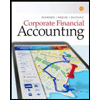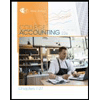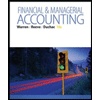
Concept explainers
1.
Journalize the given transactions in the books of Company N.
1.
Explanation of Solution
Debit and credit rules:
- Debit an increase in asset account, increase in expense account, decrease in liability account, and decrease in
stockholders’ equity accounts. - Credit decrease in asset account, increase in revenue account, increase in liability account, and increase in stockholders’ equity accounts.
Journalize the given transactions in the books of Company N.
Transaction on March 20:
| Date | Account Titles and Explanation | Post Ref. | Debit ($) | Credit ($) | ||
| 20-- | ||||||
| March | 20 | Cash Dividends | 27,000 | |||
| Preferred Dividends Payable | 9,000 | |||||
| Common Dividends Payable | 18,000 | |||||
| (Record declaration of preferred and common dividends) | ||||||
Table (1)
Description:
- Cash Dividends is a contra-capital temporary account. This account decreases stockholders’ equity and is closed as the dividends are paid off. So, the account is debited.
- Preferred Dividends Payable is a liability account. Since the liability to pay dividends increased, liability increased, and an increase in liability is credited.
- Common Dividends Payable is a liability account. Since the liability to pay dividends increased, liability increased, and an increase in liability is credited.
Working Notes:
Compute amount of preferred dividends declared.
Compute amount of common dividends declared.
Transaction on April 15:
| Date | Account Titles and Explanation | Post Ref. | Debit ($) | Credit ($) | ||
| 20-- | ||||||
| April | 15 | Preferred Dividends Payable | 9,000 | |||
| Common Dividends Payable | 18,000 | |||||
| Cash | 27,000 | |||||
| (Record payment of dividends) | ||||||
Table (2)
Description:
- Preferred Dividends Payable is a liability account. Since the liability to pay dividends has been paid off, liability decreased, and a decrease in liability is debited.
- Common Dividends Payable is a liability account. Since the liability to pay dividends has been paid off, liability decreased, and a decrease in liability is debited.
- Cash is an asset account. The amount is decreased because cash is paid as dividends, and a decrease in assets should be credited.
Note: Refer to Equations (1) and (2) for the value and computation preferred and common dividends.
Transaction on October 10:
| Date | Account Titles and Explanation | Post Ref. | Debit ($) | Credit ($) | ||
| 20-- | ||||||
| October | 10 | Cash Dividends | 27,000 | |||
| Preferred Dividends Payable | 9,000 | |||||
| Common Dividends Payable | 18,000 | |||||
| (Record declaration of preferred and common dividends) | ||||||
Table (3)
Description:
- Cash Dividends is a contra-capital temporary account. This account decreases stockholders’ equity and is closed as the dividends are paid off. So, the account is debited.
- Preferred Dividends Payable is a liability account. Since the liability to pay dividends increased, liability increased, and an increase in liability is credited.
- Common Dividends Payable is a liability account. Since the liability to pay dividends increased, liability increased, and an increase in liability is credited.
Working Notes:
Compute amount of preferred dividends declared.
Compute amount of common dividends declared.
Transaction on November 10:
| Date | Account Titles and Explanation | Post Ref. | Debit ($) | Credit ($) | ||
| 20-- | ||||||
| November | 10 | Preferred Dividends Payable | 9,000 | |||
| Common Dividends Payable | 18,000 | |||||
| Cash | 27,000 | |||||
| (Record payment of dividends) | ||||||
Table (4)
Description:
- Preferred Dividends Payable is a liability account. Since the liability to pay dividends has been paid off, liability decreased, and a decrease in liability is debited.
- Common Dividends Payable is a liability account. Since the liability to pay dividends has been paid off, liability decreased, and a decrease in liability is debited.
- Cash is an asset account. The amount is decreased because cash is paid as dividends, and a decrease in assets should be credited.
Note: Refer to Equations (3) and (4) for the value and computation preferred and common dividends.
Transaction on November 17:
| Date | Account Titles and Explanation | Post Ref. | Debit ($) | Credit ($) | ||
| 20-- | ||||||
| November | 17 | Stock Dividends | 117,000 | |||
| Stock Dividends Distributable | 18,000 | |||||
| Paid-In Capital in Excess of Par–Common Stock | 99,000 | |||||
| (Record declaration of stock dividends) | ||||||
Table (5)
Description:
- Stock Dividends is a contra-stockholders’ equity temporary account. This account decreases stockholders’ equity and is closed to
Retained Earnings account as the common stock is issued. So, the account is debited. - Stock Dividends Distributable is a stockholders’ equity account. Since common stock is declared to be issued as stock dividends, at par value, equity value is increased. An increase in equity is credited.
- Paid-In Capital in Excess of Par–Common Stock is a stockholders’ equity account. Since the stock is issued in excess of par value, equity value is increased. An increase in equity is credited.
Working Notes:
Compute the number of shares to be distributed as stock dividends.
Compute amount of stock dividends (Refer to Equation (5) for stock dividend shares value).
Compute the amount of stock dividends distributable (Refer to Equation (5) for stock dividend shares value).
Compute paid-in capital in excess of par-common stock (Refer to Equations (6) and (7) for stock dividends and stock dividends distributable value).
Transaction on December 15:
| Date | Account Titles and Explanation | Post Ref. | Debit ($) | Credit ($) | ||
| 20-- | ||||||
| December | 15 | Stock Dividends Distributable | 18,000 | |||
| Common Stock | 18,000 | |||||
| (Record issue of stock dividends in the form of common stock) | ||||||
Table (6)
Description:
- Stock Dividends Distributable is a stockholders’ equity account. Since common stock is issued due to declaration of stock dividends, the value is transferred to common stock, the equity value is decreased. A decrease in equity is debited.
- Common Stock is a stockholders’ equity account. Since common stock is issued, equity value is increased. An increase in equity is credited.
Note: Refer to Equation (7) for value and computation of stock dividends distributable value.
Transaction on December 31:
| Date | Account Titles and Explanation | Post Ref. | Debit ($) | Credit ($) | ||
| 20-2 | ||||||
| December | 31 | Income Summary | 260,000 | |||
| Retained Earnings | 260,000 | |||||
| (Record net income being closed to Retained Earnings account) | ||||||
Table (7)
Description:
- Income Summary is a temporary account used to close the net balance of revenue and expense accounts. Since the net income is closed to Retained Earnings account, the Retained Earnings is credited and Income Summary account is debited.
- Retained Earnings is a stockholders’ equity account. Since revenues are transferred to the account, the value increased, and an increase in equity is credited.
Transaction on December 31:
| Date | Account Titles and Explanation | Post Ref. | Debit ($) | Credit ($) | ||
| 20-2 | ||||||
| December | 31 | Retained Earnings | 171,000 | |||
| Cash Dividends | 54,000 | |||||
| Stock Dividends | 117,000 | |||||
| (Record dividends being closed to Retained Earnings account) | ||||||
Table (8)
Description:
- Retained Earnings is a stockholders’ equity account. Since dividends are transferred to the account, the value decreased, and a decrease in equity is debited.
- Cash Dividends is a stockholders’ equity account. Since the cash dividends are closed to Retained Earnings, the account is reversed and credited.
- Stock Dividends is a stockholders’ equity account. Since the stock dividends are closed to Retained Earnings, the account is reversed and credited.
Note: The total cash dividends paid is $54,000
2.
2.
Explanation of Solution
Posting transactions: The process of transferring the journalized transactions into the accounts of the ledger is known as posting the transactions.
T-account: The condensed form of a ledger is referred to as T-account. The left-hand side of this account is known as debit, and the right hand side is known as credit.
Post the entries that effect the retained earnings balance into the Retained Earnings T-account.
| Retained Earnings–Appropriated for Land Acquisition | |||
| 75,000 | January 1 | ||
| $75,000 | Balance | ||
Table (9)
| Retained Earnings–Unappropriated | |||
| 825,000 | January 1 | ||
| December 31 | 171,000 | 260,000 | December 31 |
| Total | 171,000 | 1,085,000 | Total |
| $914,000 | Balance | ||
Table (10)
3.
Prepare a statement of retained earnings of Company N for the year ended December 31, 20--.
3.
Explanation of Solution
Statement of retained earnings: This statement reports the beginning retained earnings and all the changes which led to ending retained earnings. Net income from income statement is added to and dividends is deducted from beginning retained earnings to arrive at the end result, ending retained earnings.
Prepare a statement of retained earnings of Company N for the year ended December 31, 20--.
| Company N | |||
| Statement of Retained Earnings | |||
| For the Month Ended December 31, 20-- | |||
| Appropriated: | |||
| Appropriated for land acquisition | $75,000 | ||
| Unappropriated: | |||
| Unappropriated retained earnings, January 1 | $825,000 | ||
| Add: Net income for the year | 260,000 | ||
| 1,085,000 | |||
| Less: Cash dividends | $(54,000) | ||
| Less: Stock dividends | (117,000) | (171,000) | |
| Unappropriated retained earnings, December 31 | 914,000 | ||
| Total retained earnings, December 31, 20-- | $989,000 | ||
Table (11)
Hence, statement of retained earnings of Company N shows the ending total retained earnings of $989,000 for the year ended December 31, 20--.
Want to see more full solutions like this?
Chapter 21 Solutions
COLLEGE ACCOUNTING CH. 1-9 (LOW COST)
- Hi expert please given correct answer with accounting questionarrow_forwardGeneral accounting questionarrow_forwardHemsworth Electronics company has a beginning finished goods inventory of $24,500, raw material purchases of $35,600, cost of goods manufactured of $42,800, and an ending finished goods inventory of $27,300. The cost of goods sold for this company is?arrow_forward
- Thunderstorm Industries, which produces a single product, has provided the following data concerning its most recent month of operations: Details Selling price Units beginning inventory Units produced Units sold Units in ending inventory Values $110 0 7,200 6,800 400 Variable costs per unit: Direct materials $15 Direct labor $48 Variable manufacturing overhead $9 Variable selling and administrative $8 Fixed costs: $198,000 Fixed manufacturing overhead Fixed selling and administrative expenses $32,000 The company produces the same number of units every month, although the sales in units vary. The company's variable costs per unit and total fixed costs remain constant from month to month. What is the unit product cost for the month under absorption costing?arrow_forwardWhat is the total sales volume in terms of the constitution margin?arrow_forwardKindly help me with this General accounting questions not use chart gpt please fast given solutionarrow_forward
- Please provide the answer to this general accounting question using the right approach.arrow_forwardPlease provide the solution to this financial accounting question using proper accounting principles.arrow_forwardDeluxe Industries used direct materials totaling $78,350; direct labor incurred totaled $217,600; manufacturing overhead totaled $389,200; Work in Process Inventory on January 1, 2022, was $195,400; and Work in Process Inventory on December 31, 2022, was $204,300. What is the cost of goods manufactured for the year ended December 31, 2022? Help me with thisarrow_forward
 College Accounting, Chapters 1-27AccountingISBN:9781337794756Author:HEINTZ, James A.Publisher:Cengage Learning,
College Accounting, Chapters 1-27AccountingISBN:9781337794756Author:HEINTZ, James A.Publisher:Cengage Learning, Corporate Financial AccountingAccountingISBN:9781305653535Author:Carl Warren, James M. Reeve, Jonathan DuchacPublisher:Cengage Learning
Corporate Financial AccountingAccountingISBN:9781305653535Author:Carl Warren, James M. Reeve, Jonathan DuchacPublisher:Cengage Learning Accounting (Text Only)AccountingISBN:9781285743615Author:Carl Warren, James M. Reeve, Jonathan DuchacPublisher:Cengage Learning
Accounting (Text Only)AccountingISBN:9781285743615Author:Carl Warren, James M. Reeve, Jonathan DuchacPublisher:Cengage Learning College Accounting, Chapters 1-27 (New in Account...AccountingISBN:9781305666160Author:James A. Heintz, Robert W. ParryPublisher:Cengage Learning
College Accounting, Chapters 1-27 (New in Account...AccountingISBN:9781305666160Author:James A. Heintz, Robert W. ParryPublisher:Cengage Learning Financial AccountingAccountingISBN:9781305088436Author:Carl Warren, Jim Reeve, Jonathan DuchacPublisher:Cengage Learning
Financial AccountingAccountingISBN:9781305088436Author:Carl Warren, Jim Reeve, Jonathan DuchacPublisher:Cengage Learning Financial & Managerial AccountingAccountingISBN:9781285866307Author:Carl Warren, James M. Reeve, Jonathan DuchacPublisher:Cengage Learning
Financial & Managerial AccountingAccountingISBN:9781285866307Author:Carl Warren, James M. Reeve, Jonathan DuchacPublisher:Cengage Learning





